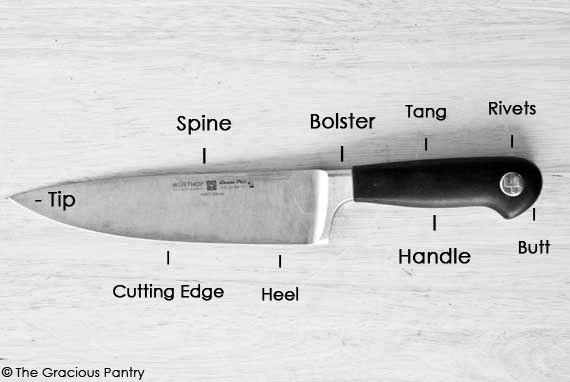Parts Of A Knife
If you know the parts of a knife, using one in the kitchen becomes a better experience. Knowing what each part is, what it’s meant for and how to take care of it is important for this indispensable kitchen tool.

Check out How To Hone A Knife here.
A well made knife is a thing of beauty. It adds to your speed and confidence. There isn’t much you can’t do in the kitchen with a well made and well suited knife.
In order to select a good one, it helps to know a little about the tool itself.
I am fortunate enough to have a good set of knives now. The benefits of which I was completely unaware of before I had them. I mean, what’s the big deal? If it’s cuts, it’s all good! Right?
Ummm…. no. I’m here to tell you that is just not the case. It’s worth it to at least invest in a single good knife. Something you can use for chopping, slicing and dicing. Something like the knife above. My second choice would be a good pairing knife. But that’s another blog post…
PARTS OF A KITCHEN KNIFE
- Tip: The tip of a knife can vary. Some are curved or flat and others are pointed. The tip of your knife is typically used for carving or cutting small pieces of food.
- Spine: The spine of your knife is wider than your blade and is blunt on top. This allows you to put pressure on the knife and what you are cutting without cutting your hand. It also helps with grip. The larger the knife, the thicker the spine will typically be in better made knives.
- Bolster: The bolster is there for balance. This is the point where the blade becomes thick at the very end. It is part of the metal piece that is the blade, though it is not sharp and does not cut. It gives the knife a bit of weight and is also a sign of a well made knife. It gives a bit of extra support for your grip as well. Lower quality knives typically do not have this, or if they do, it is not part of the blade but rather the handle.
- Tang: The tang is the portion of the blade that sits inside the handle. The part that attaches to the handle that you grip. On some knives, you can see the edge of it running along the edge of the handle (it looks like a stripe of metal down the middle of the handle). Better knives have a tang that runs the entire length of the handle. Lower quality knives will have tangs that only go about half way into the handle and you usually don’t see the edge of a shorter tang because of it.
- Rivets: These are the metal pieces (like nails or screws) that hold the tang in the handle. On some knives, you can see them. On others (like mine) you cannot.
- Butt: The butt of a knife can be used as a tool if it is well made. It can be used to tenderize or to grind (although I find other tools more useful for these things).
- Handle: I think it’s pretty self explanatory that this is the part that you grip. But it’s also the part that houses the tang. Essentially, a handle allows you to grasp the tang so you can use the knife. A handle should have a comfortable grip.
- Heel: The heel is the very back portion of the blade edge. On bigger knives, this can be up to about 2 inches of the blade. The smaller the knife, the smaller the heel gets accordingly. The heel is typically used for cutting food that needs a little extra force to be cut. It’s also the widest part of the spine for that same reason. It gives you control over cutting harder-to-cut items.
- Cutting Edge: This is the sharp part of your knife. This is what does the cutting work. Different edges have different purposes and I will cover that in a future blog post as well.
I hope this helps you get to know your knife a bit better. It might sound silly to some, but knowing this stuff really does make a difference if you are really into cooking.

